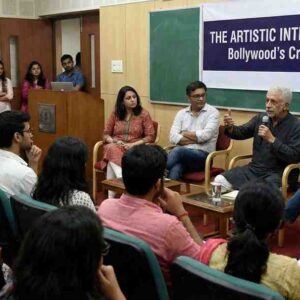Key Metrics (2024–2025):
• Netflix-Red Chillies: New Hindi-English thriller series in development (announced Jan 2025)
• Abu Dhabi Film Commission: Offering up to $10 million in rebates for Indo-Hollywood collaborations (Source: ADFC Press Release)
• Lionsgate India: Partnered with Endemol Shine and Dharma Productions for multilingual content (Source: Lionsgate Corporate Updates)
• Increase in Indo-Hollywood co-productions since 2020: Over 40 joint projects, up from 18 between 2010–2019 (Source: FICCI Frames Report 2024)
A New Era of Cross-Border Cinema
As global content consumption diversifies and digital platforms erase geographic boundaries, Bollywood and Hollywood are increasingly finding common ground in the form of structured co-productions. From multilingual series to theatrical features, collaborations between Indian and Western studios have expanded in both volume and ambition.
Netflix’s announcement of a new bilingual thriller series co-produced with Shah Rukh Khan’s Red Chillies Entertainment highlights the trend. Scheduled for a late 2025 release, the show will feature both Indian and international talent, and will be shot across Mumbai and London. It aims to cater to South Asian diaspora audiences while tapping global thriller markets.
The Role of Government and Incentive Policies
Abu Dhabi Film Commission (ADFC) has become a prominent facilitator of Indo-Hollywood collaborations. As of 2024, it offers up to 30% rebate on production costs, with an additional $10 million pool earmarked specifically for India-based co-productions. This policy has attracted filmmakers from Dharma Productions, Lionsgate, and Amazon Studios to shoot cross-border narratives in the Middle East.
India’s Ministry of Information and Broadcasting has also streamlined single-window clearance for foreign studios collaborating with Indian production houses. According to the FICCI-EY 2024 Media and Entertainment Report, these steps have improved turnaround time for large-scale international shoots in India by nearly 40%.
Studio Strategy: Storytelling That Travels
Lionsgate India, which entered into a development agreement with Endemol Shine and Dharma, is now producing multilingual feature films and OTT series with dual markets in mind. Projects are typically conceptualized with both Hindi and English dialogues, ensuring seamless integration for global audiences. One such film—a family comedy with an Indian-American protagonist—is scheduled for a theatrical release in the US, UAE, and India simultaneously.
Co-productions are no longer superficial cultural mashups; they are narratives that respect both cinematic styles. Stories of migration, diaspora identity, and transnational romance are replacing outdated East-meets-West tropes. This has enhanced critical reception and international festival participation.
Challenges and Creative Integration
Despite the momentum, co-productions face challenges. Currency conversion risks, differing union regulations, and creative disagreements about narrative tone often create friction. However, industry insiders claim that the rising professionalism of Indian crews, improvements in post-production infrastructure, and growing international trust are helping bridge these gaps.
Platforms like Amazon Prime Video are playing the role of mediator and distributor, ensuring consistent quality while allowing local flavor to flourish. Cultural consultants and bilingual scriptwriters are becoming standard in cross-border writing rooms, making stories more authentic.
Conclusion: Shared Screens, Shared Stories
The intersection of Bollywood and Hollywood in 2025 represents more than market expansion—it marks a new cultural symbiosis. As streaming platforms push for fresh content that speaks across geographies, Indo-Hollywood co-productions are becoming the most powerful example of truly global cinema.
By combining India’s emotional storytelling with Hollywood’s production scale and reach, the industry is witnessing the birth of content that is local in depth, and global in appeal.












